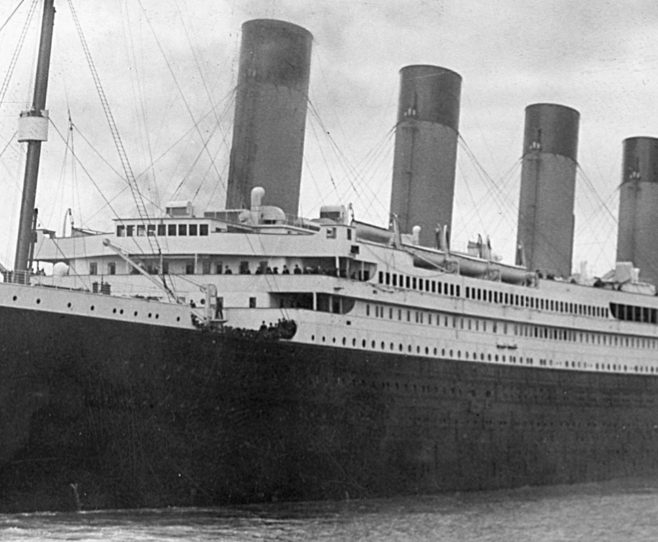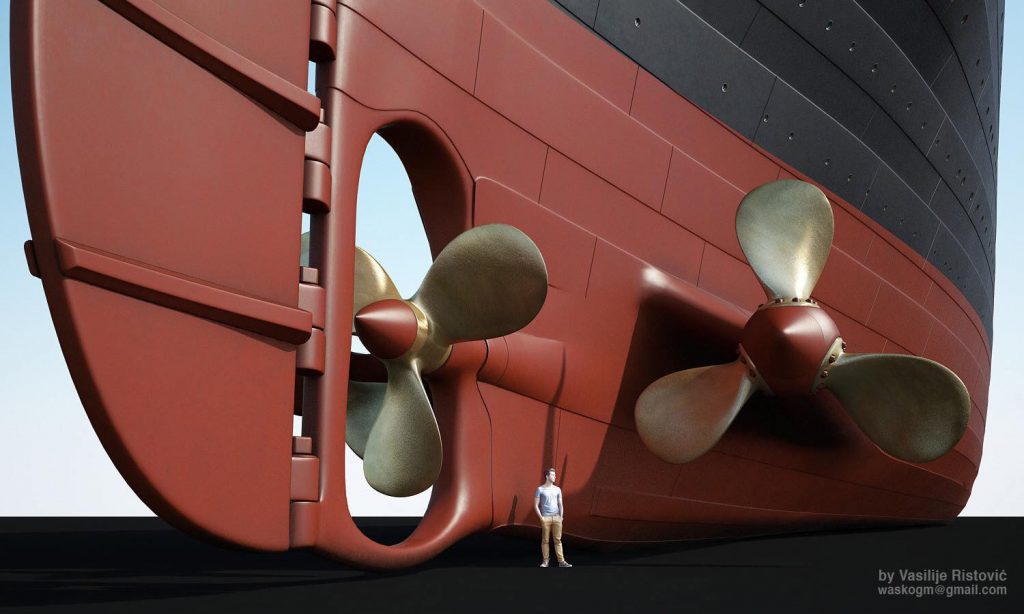FAQ: Were Olympic, Titanic & Britannic Built to the Same Standard of Strength?
A question came up a while ago in an online discussion forum concerning the construction of the three ‘Olympic’ class ships. The poster asked: ‘I mainly want to know if one was built a little stronger than the other’. The issue of strength is a complex one. However, my answer to that is that all three ships were built to the same standard of strength. I’ll explain an example of that standard.
William David Archer, who was the Principal Ship Surveyor to the Board of Trade (since 1898), explained how a key measure of strength was calculated, to take into account the ship’s structure [scantlings], length, weight [displacement] and tendency to bend:
24323. How do you test your standard of strength – how do you arrive at your standard of strength apart from the question of scantlings?
– We do this. We get from the builders the drawings of the vessel. One of these drawings is a midship section. That midship section is a section as if you cut the ship right through the middle. It shows the thickness of all the plates, the longitudinal members of the ship – for example, the thickness and width of all the plates forming the skin of the ship and the deck of the ship.
24324. But those are the scantlings, are they not?
– Those are the scantlings of the ship. We then make an estimate of what the stress on the gunwale of that ship in tons per square inch will be, on the assumption that the vessel is subjected to a bending moment equal to the whole displacement of the ship, in this case about 52,000 tons multiplied by one -thirtieth of the vessel’s length. In that way we get at a certain figure of so many tons per square inch on the shear strake [hull plating at the side of C-deck].
In the case of Olympic and Titanic, that estimate of stress came to 9.89 tons per square inch. This is very much in line with the standard shipbuilders of the period worked to for mild steel ships, which was to work to about 10 tons or less. On this measure, they were about the same or stronger than all the other large liners of the period that I have data for, excepting Oceanic and Aquitania. The figure may have differed slightly for Britannic, because she was a little wider and had a correspondingly greater weight (displacement) of about 1.6 per cent, which would have increased her bending moment.
We know from the Olympic/Titanic and Britannic midship section plans that the fundamental structural details of all three ships (including the keel, double bottom, hull plating, hull frames, columns, pillars, deck beams, etc.) were all the same. The scantlings (dimensions and thicknesses of these key structural components) were the same. There should be nothing surprising about this. Although we hear so much about the substantially greater size of these ships measured by gross tonnage, in terms of displacement they were ‘only’ about 27 percent heavier than ships such as Adriatic. Harland & Wolff had a lot of practical experience as well as theoretical design principles to determine the structural design requirements. By way of some benchmark comparisons, it is telling that these ships’ scantlings are very similar to other large liners of the period such as Lusitania (1907), Aquitania (1914), Imperator/Berengaria (1913). They are also comparable to Queen Mary (1936).
Harland & Wolff were also familiar with the standards of Lloyd’s classification society. Naval architect Edward Wilding said that ‘about one-third to one-half’ of the ships Harland & Wolff built were classed by Lloyds. He was questioned about Lloyds requirements as well as Olympic’s construction (both as built in 1911 and following the modifications to improve her watertight subdivision in 1912-13) when he testified for the Limitation of Liability hearings in May 1915:
Q. When you have mentioned the construction of the Olympic, have you referred to the original construction of the Olympic or the construction as she is today?
– The construction is generally the same, as structurally we have made very little change.
He went on to say:
Q. Do you mean to say that from your knowledge of the customs at Lloyds the Titanic would have been passed at Lloyds without any change whatever?
– I can’t put it any higher than this: I believe if we were to offer the Olympic today to Lloyds they would class her without making any further requirement. I have no authority for it, though.
Q. That is, the Olympic in her present condition?
– Or as she was finished originally. We have made no change that would affect Lloyds classification; none of the changes made would have affected Lloyds’ views as to classing her.
Wilding stated that Harland & Wolff had to do fewer repairs to Olympic than any other large ship they had built. Their experience operating Olympic in both summer and winter conditions up to early 1912 led them to make only minor modifications, including to the foremost hatch design and its cover. The result was that, when ‘Yard Number 433’ (Britannic) was ordered in 1911, her structural design and scantlings were a duplicate of Olympic/Titanic in all major respects.
When, following the Titanic disaster, White Star specified that Olympic and Britannic needed to be modified to float with an unprecedented number of watertight compartments flooded, the only reason that some of the watertight bulkheads (and the watertight doors in them) were strengthened was because those particular watertight bulkheads were being extended so much higher. The original watertight bulkheads were already built to a very high standard of strength. The plating and stiffening were both well in excess of Lloyd’s requirements which post-dated the Titanic disaster and the Board of Trade had noted the strength of the bulkheads throughout was ‘very ample’, after doing a detailed comparison between the structural design compared to what the regulations required. Edward Wilding noted that a head of water ‘about 150 feet’ deep from the bottom of the watertight bulkheads would have been needed to break the lower part of them, which was many times higher than the head of water they would ever have been called upon to hold back. Nonetheless, to ensure a good margin of safety the watertight bulkheads which were raised were also strengthened further.
We know Cunard changed aspects of Aquitania‘s design to bring her closer into line with Olympic after their naval architect, Leonard Peskett, examined her in 1911. In 1925, the Board of Trade’s Chief Ship Surveyor used comparative data from Olympic as a benchmark example of a strong ship, as did a professional from the consultant naval architectural firm Roscoe & Little, based in Liverpool. Roscoe & Little were doing an analysis of options for different schemes of repair to the White Star liner Majestic (originally HAPAG’s Bismarck, launched in 1914), which had suffered a significant structural failure in stormy seas during December 1924. Those schemes ranged from a minimalist one restoring Majestic to her strength as originally completed in 1922, to a much more substantial proposal which would significantly increase her strength. (Roscoe & Little noted that under the minimalist scheme of repair, they estimated that Majestic would be about 20 percent weaker than Olympic.) These examples help illustrate the context in which shipbuilding professionals viewed Olympic at the time.
There seem to be many people who think Titanic was a ‘weak’ ship, given that she broke up in the final stage of sinking. In reality, her stern was lifted out of the water for an extended period, subjecting her to stresses a multiple of what she would have experienced in the worst North Atlantic storm. Any structure will fail if it is subjected to stresses far beyond what it was designed for. That hasn’t stopped all too many conspiracy theorists taking key details out of context in recent years.

Above: Olympic as built, 1911. Eight of the fifteen watertight bulkheads extended up to D-deck and the remainder to E-deck. Her watertight subdivision was designed on the basis that she needed to float with any two compartments flooded, but Harland & Wolff built in such a margin of safety that she was largely a three-compartment ship. She would also float in a number of scenarios with four compartments flooded. (The Shipbuilder, 1911/Bruce Beveridge collection – modified to show the outline of watertight bulkheads)





















